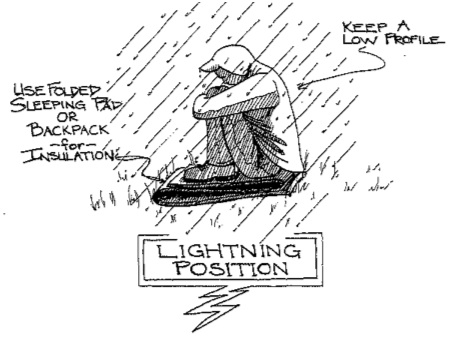With spring comes early afternoon showers and often lightning storms in the high country. Mountaineers and backpackers alike take extra precautions during the times of year lightning storms are likely to exist. Best practices for a peak ascent include getting an “alpine start;” a start before first light to assure you summit and begin descent of a peak before lightning storms typically set in. As we all know, mother nature is unpredictable and should you find yourself in the face of a lightning storm in the high country, here is some helpful information and techniques to keep in mind. Straight from the pages of the Hurricane Island Outward Bound School Backpacking and Canoeing Handbook:
Lightning
What is Lightning?
Lightning is a huge electric spark that can occur between the clouds and the earth, between two clouds, or within the same cloud. Lightning’s strong electrical current heats and causes a sudden expansion of air, which produces a sound wave – the boom of thunder.

If the storm is on top of you, it’s best if you can squat on your ensolite pad. When you tire of this you can sit down.
How Does It Happen?
Electrical potential builds up in a cloud somewhat in the same manner your body picks up an electrical charge when scuffing your feet on a carpet. The friction of scuffing creates an electric potential or charge. Your body retains the negative charge, which will ground itself with a stinging zap when you touch a doorknob for example.
How Do I Know When a Thunderstorm Is Approaching?
Light waves travel much faster than sound waves. The flash of lightning is for all practical purposes seen instantaneously. The boom of thunder arrives later, covering 1100 feet per second, or roughly 1 mile in 5 seconds. By counting “one, one thousand, and two, one thousand, etc.” the distance from you to the lightning can be estimated. Every five seconds between lightning and thunder equals about one mile of distance between you and the storm.
Minimizing Danger on Land
1. Time visits to high risk area with weather patterns
2. Find safer terrain if you hear thunder
3. Avoid trees, peaks, ridges, wide open ground, high ground, water, cave entrances
4. Avoid long conductors (metal structures, wire cables, railway tracks)
5. Get in the lightning position (see illustration above).
Please keeps these important tips in mind on your next mountaineering adventure.
Resource:
Gookin, John, NOLS Backcountry Lightning Safety Guidelines
OTHER POSTS YOU MAY LIKE
Read More
Read More
Read More




